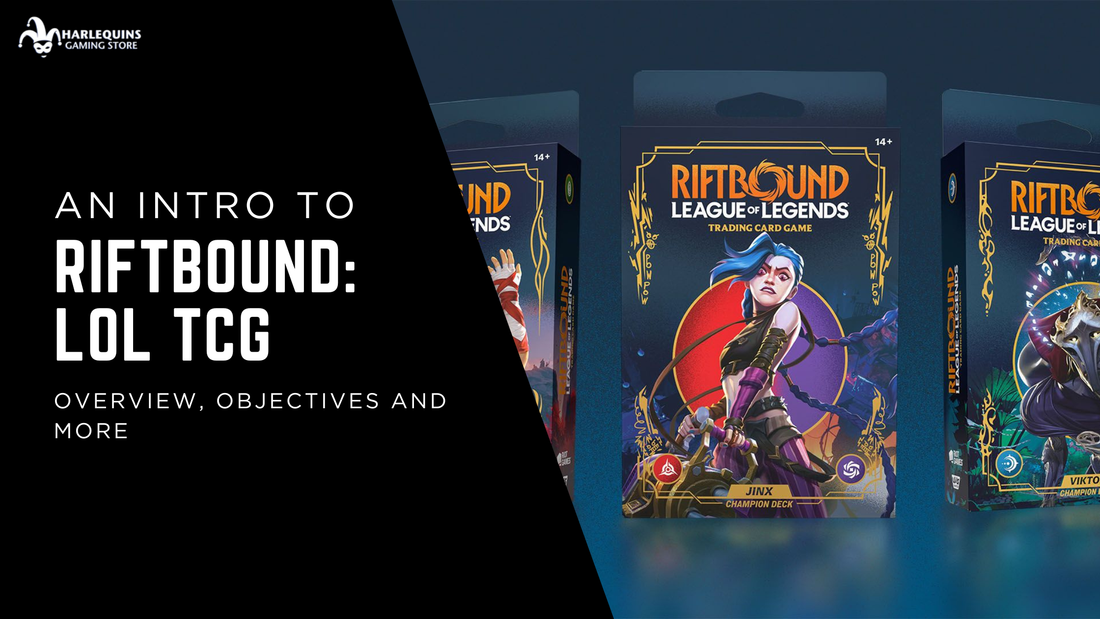
What is Riftbound? The New League of Legends TCG
Share
Overview
Riftbound is the official physical trading card game set in the world of Runeterra. It is developed by Riot Games and designed for 2 to 4 players. Instead of focusing on reducing an opponent’s life total, the game is built around controlling shared zones called Battlefields to earn points. This creates a tug of war structure that rewards strong decision making and precise timing.
The game combines familiar elements of trading card gameplay with iconic League of Legends themes. It is structured for both casual players and a future competitive scene. These details are based on official gameplay rules and launch information.

Core Objective
- Players score points by capturing and holding Battlefields during the match.
- In a 1v1 match, the first to reach 8 points wins.
- In team formats such as 2v2, the first team to reach 11 points wins.
- Free for all formats use point totals based on player count.
- Control of zones can shift several times over the course of a game.
These rules create a highly interactive structure where no lead is guaranteed until the final point is scored.
Deck Structure and Setup
- Every deck is built around a Champion Legend card placed face up at the start of the game.
- Your chosen Champion determines your deck’s two domains in the Origins set. Domains shape your available card pool and guide deck construction.
- Each deck includes a Main Deck, a separate Rune Deck that provides resources, and a Battlefield card that enters the contested zone pool.
- Deck building rules include minimum deck size and card copy limits.
This structure blends the identity of League of Legends champions with trading card game strategy. Domains keep decks thematic while allowing room for creative approaches.
If you're looking for singles for your deck check out our massive collection!

Gameplay Flow and Key Mechanics
- Channel Runes: At the start of your turn, you gain two runes from your Rune Deck.
- Ready Units and Runes: You prepare any exhausted resources or units for use again.
- Play Cards: Cards are paid for by exhausting runes or returning them to the bottom of the deck for a stronger effect.
- Deploy Units and Champion: You bring your Champion and other units onto the board to contest Battlefields.
- Move and Fight: When units move to an opponent’s Battlefield, combat takes place.
- Score Points: Gaining control of a Battlefield awards points. Maintaining control gives more points at the start of your turn.
This flow creates tension every turn. Resource management, deployment timing, and combat sequencing all play crucial roles.
Combat and Showdowns
When opposing players contest the same Battlefield, a Showdown occurs.
- Combat strength is determined by comparing each side’s Might values.
- Units that receive damage equal to or greater than their Might are removed from the Battlefield.
- If one side remains after the fight, control of the Battlefield shifts to that player or team.
- Control of a Battlefield scores a point and sets up additional points on future turns if uncontested.
This combat structure encourages careful positioning and smart trades instead of reckless aggression.
Winning Conditions and Advanced Rules
- Victory in 1v1 comes at 8 points. Victory in 2v2 comes at 11 points.
- Control of Battlefields is the only way to win the match.
- Official Core Rules define deck building, combat resolution, timing structure, and tournament standards.
Because points come from controlling areas rather than dealing damage, matches often stay close until the very end. Many games are decided by a single battlefield swing in the late turns.
Launch Products and Format Details
- The first set is named Origins and contains more than 300 cards.
- Launch products include Champion Decks, 14 card booster packs, and the Proving Grounds box for 2 to 4 players.
- Draft and sealed formats are planned for organised play, encouraging both competitive and casual scenes.
- Deck construction in sealed involves building from a limited pool of opened cards, similar to other major TCGs.
These product types allow new players to start quickly and give advanced players multiple ways to engage with the game.
Community Insights and Player Impressions
- Many early players describe the game as easy to learn but challenging to master.
- Some community members compare it to a strategy board game supported by a TCG model.
- Players have expressed enthusiasm for the lore connection to Runeterra, even among those who do not actively play League of Legends.
- There is active discussion about digital support and organised play structures on community forums.
These comments reflect growing excitement and curiosity around the game. Players seem to appreciate the balance between accessibility and strategic depth.
Speculation and Future Expectations
- Regular expansions introducing new Champions, domains, and battlefields are widely expected by players and commentators.
- Many believe that Riot may create a global tournament structure or support organised play events similar to other top trading card games.
- There is active community speculation about a digital version, though nothing has been officially confirmed.
- Future expansions may include additional mechanics such as alternate battlefield effects or champion equipment.
These expectations come from community discussions and patterns seen in similar trading card game launches. None of these items are confirmed by Riot Games at this time.
Why TCG and League Players Are Excited
Riftbound brings something different to the trading card game space. Its victory condition centers on battlefield control, creating a style of play that rewards patience, calculation, and momentum shifts. For TCG players, the rune system offers reliable resource access with strategic decisions built in. For League of Legends fans, the game provides familiar champions, abilities, and worldbuilding in a new format.
Community discussion shows that many players like how the game creates tension through territory control. A single decisive combat can change the entire match, which gives it strong replay value.
The League of Legends Universe is also expanding with Riftbound, giving opportunity to new lore drops to complement arcane, 2xKO and all the other side projects riot has it's fingers in.
Getting Started Tips
- New players are encouraged to begin with a Champion Deck to learn core mechanics quickly.
- Building around your Champion’s domains keeps your strategy consistent and efficient.
- Tracking rune usage carefully is one of the fastest ways to improve at the game.
- Early control of a Battlefield can lead to steady points, so identifying when to commit to a fight is important.
- Watching experienced players or reading match breakdowns can help shorten the learning curve.
Early community advice focuses on pacing, patience, and smart rune usage rather than rushing every fight.
Final Thoughts
Riftbound has built early momentum through clear rules, accessible mechanics, and a familiar universe. It is rooted in the strategy of trading card games but offers a distinct focus on zone control that sets it apart. The official rules are straightforward enough for new players to learn quickly, while the layered gameplay offers room for high-level strategy.
Community impressions point toward cautious optimism. Fans of League of Legends enjoy seeing their champions represented in a fresh format. Card game veterans appreciate a system that encourages resource planning and precise timing. With a strong foundation already in place, Riftbound is positioned to grow in both casual and competitive spaces.
